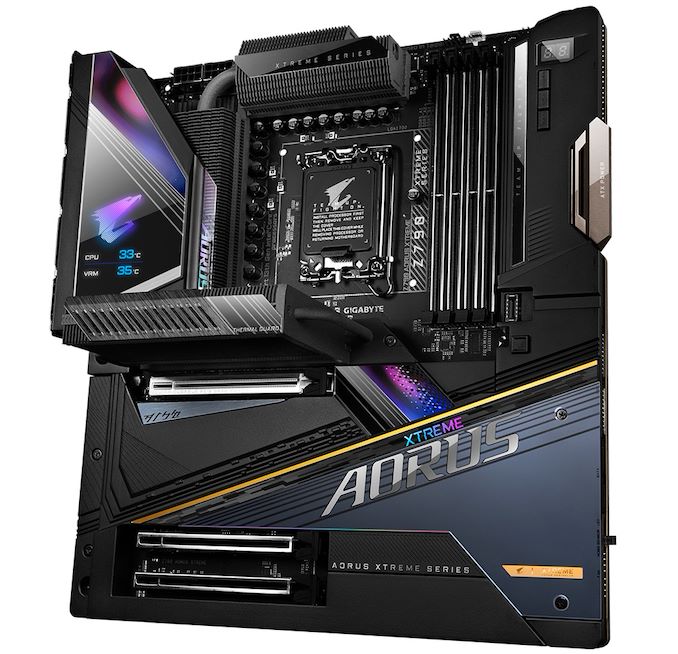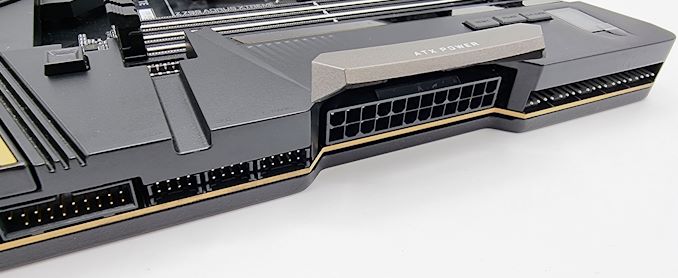GIGABYTE Z790 Aorus Xtreme Motherboard Review: Flagship Z790 With Impressive VRM Thermals
by Gavin Bonshor on September 5, 2023 9:00 AM ESTConclusion
As we have seen consistently over the last couple of years with motherboards, especially in the high-end and premium segment, vendors are trying to go all out with flashy features. Still, they all seemingly have the same core fundamentals, including large over-engineered power deliveries, higher-end networking configurations such as 10 GbE, large amounts of PCIe SSD support, and flashy cool screens that can either/or display critical system information or even custom GIFs to add that extra bit of pizazz.
One flagship model on Intel's Z790 chipset that ticks the above boxes is the GIGABYTE Z790 Aorus Xtreme; well, aside from the screen that can't display gifs, the 2.8-inch digital LCD on the rear panel cover can display a variety of system information such as CPU/VRM temps, CPU clock speed and memory clock speed. With that out of the way, the Z790 Aorus Xtreme is currently GIGABYTE's current flagship motherboard for Intel 13th and 12th gen processors, and we say current because GIGABYTE is refreshing the line-up for Intel's next generation (14th Gen) processors expected in the coming months. We'll touch more on this in our final thoughts.
Sitting at the top of GIGABYTE's Z790 motherboard stack, the Z790 Aorus Xtreme is flashy but feature-filled. First, the design is reminiscent of the quintessential Aorus-themed branding, primarily black and grey, with shades of flashy RGB LEDs integrated into the chipset heatsink and rear panel cover. The most notable aspect of the design is the nearly full-covered PCB, which is covered by various metal covers. This large mid-plate stretches across the bottom of the board and cools the majority of the M.2 slots, as the cover on the right-hand side has a power and reset button and a 2-digit LED debugger embedded into it. Overall, it's a stylish board with plenty of appeal in terms of looks.
One element to highlight around the design is GIGABYTE's cable management implementations, or as GIGABYTE calls it, Project Stealth. All of the board's power inputs and headers are located around its edge at 90° angles, giving it a cleaner look as they are covered by armor across the top. The idea is that users can plug in cables so that they protrude from the sides of the board, which should make things look tidier and aid in making cable management easier when installed into a chassis. We like this kind of cable management implementation, and we feel that it adds an element of quality, which every motherboard above $500 should at least include in some shape or form.
Touching on the other features of the GIGABYTE Z790 Aorus Xtreme, it has plenty of storage options, including one PCIe 5.0 x4 M.2, three PCIe 4.0 x4 M.2, and one PCIe 4.0 x4/SATA M.2 slot. Other storage options include four SATA ports for conventional SATA SSDs and HDDs, or even, dare we say it, optical drives. Memory support is impressive, with support for up to DDR5-8000, but only in a 1PDC configuration, limited to smaller capacities. Like other Z790 Aorus Xtreme, the Z790 motherboards can support the new 24 GB DIMMs with a maximum capacity of up to 192 GB across four memory slots.
Moving to the rear panel, GIGABYTE has implemented a very premium selection of input and output, with the most notable including dual Thunderbolt 4 Type-C ports and ten USB 3.2 G2 Type-A ports. Even the networking array is impressive, with a Marvel AQtion AQC107 10 GbE and Intel I225-V 2.5 GbE controller pairing, as well as a Killer AX1690 Wi-Fi 6E CNVi with access to the 6 GHz Wi-Fi band and support for BT 5.2 devices. Users looking for more Type-C connectivity can use the front panel header (USB 3.2 G2x2), and if ten USB Type-A ports on the rear panel aren't suffice, then users can add four USB 3.2 G1 Type-A and four USB 2.0 ports through the use of front panel headers.
Focusing on performance, the GIGABYTE Z790 Aorus Xtreme is competitive with other Z790 motherboards we've tested. Although non-UEFI POST times aren't going to set the world alight, we saw solid performance in power consumption with our Core i9-13900K and good DPC latency performance. In our compute and gaming benchmark suite, performance was where we would expect, and laying it out as simply as possible, most Z790 motherboards will perform to similar levels regardless of vendor or segmentation.
The most significant difference in performance comes through things like the power delivery, but more specifically, VRM thermal performance. In this area, the GIGABYTE Z790 Aorus Xtreme is impeccable, with cooler VRM temperatures than an actively cooled power delivery (Z790 Xtreme has passive), and effectively dissipating the heat through the large nanocarbon coated heatsinks; a lot of vendor's implementations over the years dumps a lot of the heat into the copper power plane around the CPU socket, but GIGABYTE does an excellent job here of keeping things cool and running efficiently.
Final Thoughts: Solid Motherboard, Cool VRMs, Refreshed Z790 Xtreme X Soon?
The GIGABYTE Z790 Aorus Xtreme is the cheapest of the leading manufacturer's flagship models at $800, which, given the features on offer, is a fair price compared to the competition. Compared to the other vendors, the MSI MEG Z790 Godlike has a price tag of $1200, which is 1/3 more than the GIGABYTE, but it has seven M.2 slots. The ASUS ROG Maximus Z790 Extreme costs $999, all with top-of-the-range flashy designs, networking arrays, plenty of PCIe M.2 storage, and premium controller sets.
As a standalone option, the GIGABYTE Z790 Aorus Xtreme does have the key features of the other flagships, especially with 10 GbE and Wi-Fi 6E networking, as well as lots of high-performance USB connectivity, including Thunderbolt 4 Type-C on the rear panel. Also offered on a plate is a large 20+1 (CPU+SOC) phase power delivery, which uses a teamed configuration for the power stages (10/10+1) and has some of the best thermal VRM performance we've seen from a high-end motherboard.
If all of that impresses you, and having one PCIe 5.0 x4 and a full-length PCIe 5.0 x16 slot is a necessity, then you would be slightly disheartened to know that effectively all Z790 motherboards have this as they are the main selling points of the Z790 chipset and Intel's 13th Gen Core series processors. What sets the Z790 Aorus Xtreme apart from the rest is all of the features such as 10 GbE, one PCIe 5.0 x4 M.2 slots, four PCIe 4.0 x4 M.2 slots, Thunderbolt 4, lots of USB 3.2 G2 Type-A, and an aesthetic and feel that screams "I am a premium motherboard, I am better than everything else". While the latter is a misnomer regarding price versus features, general compute and gaming performance across all Z790 boards we've tested is similar.
While we feel the GIGABYTE Z790 Aorus Xtreme is a solid LGA1700 motherboard that's got a lot of features and, compared to the competition, is worthy of the flagship status and with a more affordable price than the other vendor's top offerings, GIGABYTE has new boards coming. We're talking about the recently announced GIGABYTE Z790 Aorus Xtreme X motherboard, which has a similar feature set but supports slightly faster DDR5-8266 and has the latest Wi-Fi 7 CNVi. Everything else between this board and the new 'X' variant looks to be similar, and even the rear panel has the same I/O, which means GIGABYTE might be using the same or a closely similar PCB but with the new Wi-Fi 7 instead of the Wi-Fi 6E CNVi.













22 Comments
View All Comments
meacupla - Tuesday, September 5, 2023 - link
My initial thought on the E-ATX design of this mobo.They put enough thought to recess the bulky 90 degree 24pin power connector on a really long mobo. However, they left the USB-C internal header a regular 0 degree, and gave it a trench in the plastic?
Oh Gigabyte, don't ever change.
DanNeely - Tuesday, September 5, 2023 - link
Obviously the USB-C header was a last minute addition.shabby - Tuesday, September 5, 2023 - link
Lol @ the price, glws gigabyte 😂TheinsanegamerN - Tuesday, September 5, 2023 - link
$800. Christ.I remember when you could get asrock taichi x470 boards with 10g ethernet for $349, and I thought that was pricy.
Threska - Tuesday, September 5, 2023 - link
So only the upper class will be buying these? Middle class barely exists, and the poor..., oh well.Tom Sunday - Sunday, September 10, 2023 - link
I would love to own a Z790 Aorus Xtreme, but my limits just gotten pushed again when I tanked-up twenty dollars worth of gas—about 2 and a half gallons—at the Chevron gas station on Cesar Chavez Ave at the intersection of Alameda Street in downtown Los Angeles. I am just a poor PC enthusiast Bro and there are now thousands like me trying to making over the daily rounds. Thus my hardware for the past several years has always been bought at the weekend local computer shows and over the folding tables. Mostly new if even possible but several (3-4) generational ago parts for my hobbled together EATX case. No sales tax and cash remains king for the real good deals! We are living in challenging times. Moving to Montana is now in my dreams.meacupla - Tuesday, September 5, 2023 - link
No one is forcing you to buy this mobo.Taichi x470 Ultimate didn't have PCIe 5.0, DDR5 or 2xTB4 on top of 10gbe
Aspernari - Saturday, September 9, 2023 - link
A 10G Ethernet adapter is probably one of the lowest-cost components on this board. You can get a 4 port 10GbE NIC for under $100 retail.Gillll - Tuesday, September 5, 2023 - link
nowadays, your Thermal inspection should have an SSD gen 5 thermal inspection as well. as those newest SSD are quite hot. add to the fact that most M.2 PCIE5 connectors are above the GPU and below to the CPU, this is a recipe for disaster, as you can't use a better SSD HS, rather only the one provided by the motherboard manufacture, i mean you can but it probably limit your GPU or CPU HS size.blingon - Tuesday, September 5, 2023 - link
Reads like AI generated marketing copy fed with a starting term of "premium".